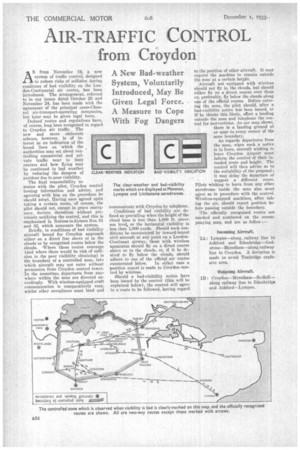-TRAFFIC CONT
Page 52

If you've noticed an error in this article please click here to report it so we can fix it.
from Croydon
AS from November 19, a new system of traffic control, designed to reduce risks of collision during conditons of bad visibility on the London-Continental air routes, has been introduced. The arrangement, referred to in our issues dated October 20 and November 24, has been made with the agreement of the principal cross-Channel air-transport-operating companies, but later may be given legal force.
Defined routes and regulations have, of course, long been recognized in regard to Croydon air traffic. The new and more elaborate scheme, however, is of interest as an indication of the broad lines on which the authorities may set about con' trolling commercial and private traffic near to busy centres and how flying may be continued in bad weather by reducing the dangers of accident due to poor visibility.
The final responsibility remains with the pilot, Croydon control issuing information and advice, and agreeing with him on the procedure he should adopt. naving once agreed upon taking a certain route, of course, the pilot should not, except in grave emergency, deviate therefrom without previously notifying the control, and this is emphasized in Notices toAirmen Nos. 81 and 82, which announce the system.
Briefly, in conditions of bad visibility aircraft bound for Croydon approach either on a direct line above or in the clouds or by recognized routes below the clouds. Where those routes converge (and where there would be risk of collision in the poor visibility obtaining) is the boundary of a controlled zone, into which aircraft may not enter without permission from Croydon control tower. In the meantime, departures from anywhere within the zone are directed accordingly. With wireless-equipped craft communication is comparatively easy, ;whilst other aeroplanes must land and communicate with Croydon by telephone.
Conditions of bad visibility are defined as prevailing when the height of the cloud base is less than 1,000 ft. above sea kvel or the horizontal visibility is less than 1,000 yards. Should such conditions be encountered by inward-bound civil aircraft at any point on a LondonContinent airway, those with wireless apparatus should fly on a direct course above or in the clouds, or, if it be desired to fly below the clouds, should adhere to one of the official air routes enumerated below. In either case a position report is made to Croydon control by wireless.
Should a bad-visibility notice have been issued by the control (this will be explained below), the control will agree to a route to be followed, having regard to the position of other aircraft. It may require the machine to remain outside the zone at a certain height.
Aircraft not equipped with wireless should not fly in the clouds, but should either fly on a direct course over them or, preferably, fly below the clouds along one of the official routes. Before entering the zone, the pilot should, after a bad-visibility notice his been issued, or if he thinks this likely, effect a landing outside the zone and telephone the control for instructions. As our map shows, there is a landing ground at or near to every corner of the zone boundary.
As regards departures from the zone, when such a notice is in force, aircraft wishing to leave Croydon Airport must inform the control of their intended route and height. The control will then advise as to the suitability of the proposal;
it may delay the departure or suggest a different route. Pilots wishing to leave from any other aerodrome inside the zone also must agree as to procedure with the control. Wireless-equipped machines, after taking the air, should report position before passing outside the boundary.
The officially recognized routes are marked and numbered on the accompanying map, and are as follow :—




































































































